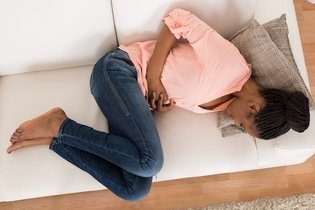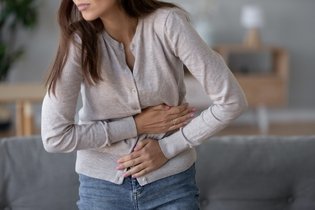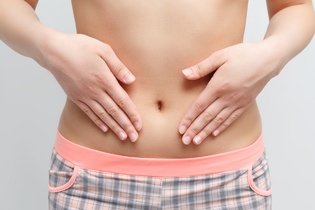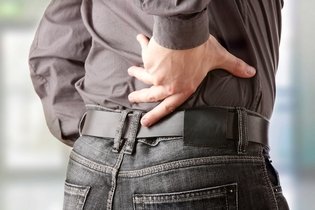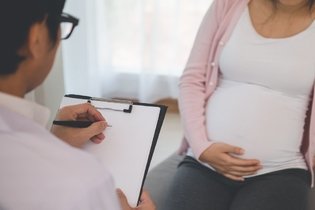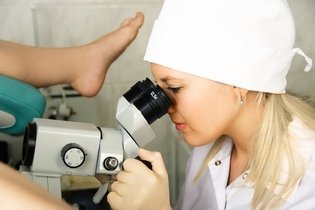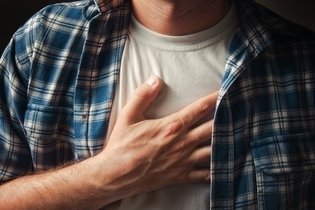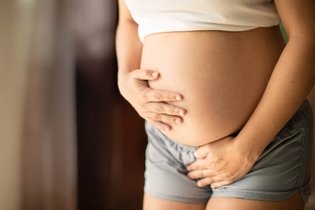Pain the the lower left abdomen is usually a sign of excess gas or constipation. Other health conditions that can cause pain in this area include gastrointestinal illnesses, like diverticulitis, abdominal hernias and indigestion. Women in particular can have lower left side abdominal pain during menstruation, with endometriosis or ovarian cysts.
The type of abdominal pain experiences can range from mild to severe, and it can be reported as a sharp or stabbing pain that comes and goes. Other symptoms that can occur with pain include bloating, a feeling of heaviness in the stomach, or regular belching.
In rare cases, pain in the lower left abdomen can also be a sign of a heart attack, but there are usually other, more specific symptoms of a heart attack that may occur, like chest pain that radiates to the stomach, nausea, shortness of breath, and tingling in the arms.
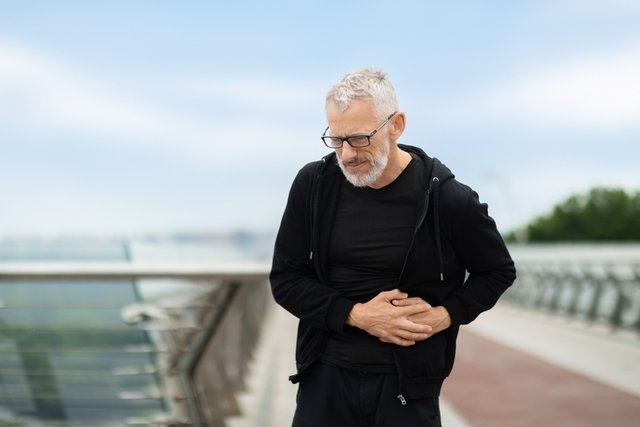
What causes lower left abdominal pain?
Many times, pain in the lower left side of the belly can be a result of:
1. Excess gas
Excess gas is one of the most common causes for abdominal pain. It frequently occurs with constipation, because when hardened stools remain in the intestines for longer periods, intestinal bacteria starts to ferment and more gas is released. Learn more about what causes excess gas.
Increase in flatulence can also be caused by swallowing more air, from talking while eating, chewing gum, or drinking pop.
[articleLink_simple:foods-that-cause-flatulence
Other related symptoms: Bloating, feeling full or heavy, lack of appetite, and belching. Read more about symptoms of excess gas.
What to do: Drink fennel tea three times a day, as fennel helps to reduce intestinal gas, or manually massage the abdomen to help with gas release. Lying on your back and hugging your legs also helps to release intestinal gas more easily. Check out other home remedies for excess gas that you can try to relieve pain.
2. Diverticulitis
This is one of the most common intestinal problems that can cause pain on the left side of the abdomen. Diverticulitis happens when small pockets of the intestines, known as diverticula, become inflamed, causing constant pain.
Other related symptoms: Fever over 38ºC (or 100.4ºF), loss of appetite, nausea, bloating, and periods of constipation and diarrhea.
What to do: If you suspect you have diverticulitis, you should go to the hospital as soon as possible to confirm a diagnosis. Diverticulitis treatment usually involves antibiotics and analgesics. In addition, you will also need to rest and eat a liquid diet, which will allow for healing of the affected intestine. Solids are then slowly re-added to the diet.
Read more about the diverticulitis diet that you can maintain to prevent and treat flare-ups.
3. Indigestion
With indigestion, pain is usually felt a few minutes after eating, and even though it is more common in the upper abdomen (near the stomach), it can also occur in the lower abdomen.
Other related symptoms: Burning sensation in the throat, bloating, nausea, belching, and fatigue.
What to do: Green tea or teas made from boldo, fennel, or peppermint aid digestion and help to relieve pain. You should also opt for lighter meals that include easily digestible foods, such as bread, crackers, or fruit. Check out some home remedies for upset stomach that you can use to naturally relieve discomfort at home.
Also recommended: Kidney Pain: 8 Common Causes & How to Treat It tuasaude.com/en/kidney-pain4. Abdominal hernia
Abdominal hernias occur when small areas in the abdominal muscles become weak, causing the intestine to bulge out. This bulge can be uncomfortable or painful, especially when laughing or coughing. Hernias are common in the groin area, and usually cause a persistent pain.
Also recommended: tuasaude.com/enOther related symptoms: A small bulge in the abdomen, redness in the affected area, nausea, and vomiting.
What to do: If you suspect you have an abdominal hernia, consult your family doctor or a gastroenterologist. He or she can confirm a diagnosis and carry out the appropriate treatment, which is usually a surgical procedure that reinforces the abdominal muscles.
Read more about that different types of hernias and what can cause them.
5. Kidney stones
Although kidney stones usually cause pain in the lower back, it is also possible to get abdominal pain, as the back pain may radiate to the front (near the bellybutton)
Kidney stones are more common in men, but can also happen in women and children, due to low fluid intake. Read more about what causes kidney stones and how they are typically treated
Other related symptoms: Very intense pain in the lower back, pain when urinating, fever over 38ºC (or 100.4ºC), nausea, red-colored urine, and difficulty lying down. Learn more about the symptoms of kidney stones.
What to do: Treatment for kidney stones is usually completed in the hospital setting. Intravenous analgesics are administered to relieve pain, however, surgical procedures may be necessary to remove or break-up the stones. If a small stone is identified in a routine exam, and it is not causing symptoms, the doctor may advise the patient to wait for the body to eliminate the stone through urine.
6. Kidney infection
A kidney infection, also referred to as pyelonephritis, is an infection of the urinary tract in which the harmful microorganisms reaches the kidneys and causes swelling It can lead to kidney cramps that radiate to the left side of the abdomen.
Also recommended: tuasaude.com/enOther symptoms: Foul-smelling urine, fever and painful urination.
What to do: To confirm the presence of a kidney infection, it is important to consult a doctor for assessment of your symptoms and urine testing. A kidney infection caused by bacteria can be treated by antibiotics, which are taken for 10 to 14 days, as advised by the doctor.
7. Period cramps
Period cramps are common in women. They usually occur 2 to 3 days before a period and can last for another 3 to 5 days after it has started. While some women may not feel any discomfort with their period, others can feel a strong pain which radiates to the left or the right side of the abdomen.
Other related symptoms: Bloating, mood swings, constant headaches, increased stress, and acne.
What to do: Exercising regularly is a great way to relieve PMS symptoms, as well as drinking passion fruit juice or doing aromatherapy with lavender essential oil. To help with chronic cramps, your doctor or gynecologist may recommend anti-inflammatories, or a birth control pill. You can also check out natural remedies for period cramps to relieve pain at home.
8. Ovarian cysts
Even though ovarian cysts rarely cause any symptoms, there are some women who may feel a slight discomfort or a light pain in the affected area.
Other related symptoms: Bloating, irregular periods, nausea, vomiting, increased breast sensitivity, discomfort during sex and difficulty getting pregnant. Learn more about ovarian cyst symptoms that can occur.
What to do: Sometimes cysts disappear spontaneously, however, it is common for an oral contraceptive pill to be prescribed. Birth control can help to regulate hormone levels and relieve symptoms. The doctor may also prescribe a surgical procedure to remove the cyst. Learn more about ovarian cysts and treatment options.
9. Endometriosis
Endometriosis is a relatively common problem that can cause intense abdominal pain, especially before and during a period. As it can be confused with PMS, some women only find out they have endometriosis when they are trying to get pregnant, since endometriosis can cause infertility.
Other related symptoms: Strong pain during sex, when passing stool, or urinating, as well as irregular bleeding and fatigue. Learn more about endometriosis symptoms that many women report.
What to do: You should see your gynecologist, who will likely order pelvic ultrasound to confirm a diagnosis. When necessary, surgical intervention may be necessary.
10. Ectopic pregnancy
Ectopic pregnancy is a common cause for left-sided abdominal pain in pregnant women. It can also happen on the right side. Pain is felt due to the growth of the fetus inside the fallopian tubes instead of the uterus, and it can happen in the first 10 weeks of pregnancy. Ectopic pregnancies are more common in women over 35, women who become pregnant with an IUD or following in-vitro fertilization.
Other related symptoms: Vaginal bleeding, a feeling of heaviness in the vagina, pain during sex, and bloating.
What to do: If you suspect you have had an ectopic pregnancy, proceed to the hospital immediately to complete an ultrasound. If confirmed, the pregnancy will need to be terminated, as the fetus will not thrive outside of the uterus.
11. Pelvic Inflammatory Disease (PID)
Pelvic inflammatory disease, or PID, is an inflammation that starts in the vagina and, when left untreated, can spread to the uterus, fallopian tubes and ovaries. It causes mild to severe pain in the lower abdomen and pelvis on both the right and left sides.
Other related symptoms: Fever, burning sensation when urinating, bleeding between menstrual cycles and pain during sexual intercourse.
What to do: you should see a gynecologist to assess your symptoms. He or she may order testing to confirm a diagnosis, such as a pelvic or transvaginal ultrasound. Treatment for PID typically involves be oral or IM antibiotics, depending on the infectious agent responsible.
Learn more about what can cause pelvic pain and what to do.
12. Ovarian torsion
An ovarian torsion is a medical emergency in women and occurs when the ovary twists on the tissues that support it. It is caused by cysts, tumors or the use of hormones and is associated with severe pain in the abdomen that can be felt on left or right side, depending on which ovary is affected.
Other related symptoms: nausea and vomiting, rapid heartbeat, in some cases, and fever.
What to do: it is important to consult a gynecologist for assessment and testing to confirm this condition. It is usually treated through surgery.
13. Testicle torsion
Testicular torsion is a condition in which one of the testicles twists around the spermatic cord. It can reduce blood circulation and lead to serious damage to the testicle if it is not treated promptly quickly. Testicular torsion is associated with severe pain in the pelvis that radiate to the left or right lower abdomen, which depends on the testicle that is affected.
Other related symptoms: intense and sudden pain in the testicles, inflammation and increased sensitivity in the scrotum, one testicle visibly higher than the other.
What to do: A diagnosis is confirmed by a urologist after performing a physical examination of the region and order imaging tests, like a testicular ultrasound. Treatment usually involves surgical intervention, in which the testicle is placed in the correct location and blood flow is restored.
When to see a doctor
Most cases of left-sided abdominal pain will improve within 2 to 3 days, especially when the pain is caused by mild conditions like excess gas or constipation.
However, you should seek medical help when:
- Pain is very intense or appears suddenly;
- Other symptoms emerge such as high fever, bloody stool, intense vomiting, or yellowish skin;
- Symptoms do not improve after two days;
- There's unexplained weight loss.
If any of these situations arise, consult your family doctor or gastroenterologist.

